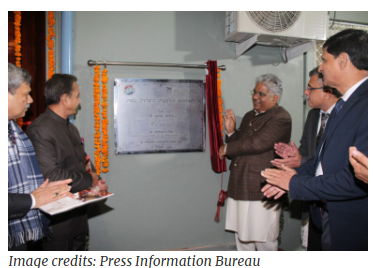
Union Minister for Environment, Forest, and Climate Change, Shri Bhupender Yadav, inaugurated two advanced facilities at the Wildlife Institute of India (WII) in Dehradun: the Next Generation DNA Sequencing (NGS) Facility and the upgraded Advanced Facility for Pashmina Certification. These state-of-the-art centres mark a significant step in integrating technology into conservation science and sustainable trade practices.

Built on a strong foundation established last year with the opening of the Pashmina Certification Centre (PCC), these facilities represent a modern approach to tackling conservation and trade challenges with precision and efficiency.
The Next-Generation Sequencing (NGS) facility introduces a revolutionary technology capable of rapidly decoding entire genomes, allowing millions of DNA sequences to be analysed simultaneously. This capability provides unprecedented insights into genetic diversity, evolutionary relationships, and wildlife population health.
NGS technology holds immense potential for addressing conservation challenges, including studying genetic adaptations to climate change, understanding pathogen-host interactions, and detecting illegal wildlife trade networks.
Additionally, it plays a crucial role in disease outbreak surveillance, enabling proactive measures to protect endangered species. Shri Bhupender Yadav highlighted the transformative power of this facility, stating that it empowers scientists with the tools to uncover the genetic mysteries of biodiversity and implement evidence-based solutions.
Shri Kirti Vardhan Singh, Minister of State for Environment, Forest, and Climate Change, emphasised the importance of developing indigenous technological expertise, pointing out that facilities like NGS enable India to handle modern conservation challenges independently while fostering innovation and self-reliance.
The NGS facility is set to support critical research projects focusing on species such as tigers, elephants, and riverine dolphins. It will help scientists understand genetic health, evolutionary barriers, and the impact of environmental changes on vulnerable populations. By enabling precise genetic analysis, the NGS technology will also play a key role in formulating long-term conservation strategies.
This facility firmly positions WII as a global leader in wildlife molecular research, paving the way for groundbreaking discoveries in biodiversity genomics and disease management.
Complementing the advancements in wildlife genomics, the upgraded Advanced Facility for Pashmina Certification brings cutting-edge technology to the forefront of sustainable trade. Equipped with a Scanning Electron Microscope (SEM) integrated with Energy Dispersive Spectroscopy (EDS), the facility ensures accurate identification and authentication of Pashmina fibres.
This enhanced precision supports the certification of genuine products, promoting transparency in the supply chain and bolstering the credibility of India’s Pashmina industry in international markets. Unique ID tagging and digital e-certificates now accompany each certified shawl, streamlining traceability and preventing fraudulent practices.
Over the past year, the Pashmina Certification Centre has certified more than 15,000 shawls, safeguarding the livelihoods of artisans and enhancing the global reputation of Indian handicrafts.
The upgraded facility also highlights a strong connection between technology, trade, and conservation. By discouraging the use of illegal fibres such as Shahtoosh, the certification process indirectly contributes to wildlife conservation, particularly protecting the endangered Tibetan antelope.
Moreover, the facility operates on a self-sustaining model under a Public-Private Partnership (PPP), generating revenue while creating employment opportunities for skilled professionals. This aligns with the broader vision of Atmanirbhar Bharat, promoting self-reliance and sustainable economic growth.
These facilities collectively underscore the government’s commitment to harnessing technology for conservation and sustainable trade. The integration of advanced scientific tools not only strengthens India’s position in global biodiversity research but also ensures the protection of cultural heritage and traditional livelihoods.
As India continues to face the dual challenges of biodiversity loss and environmental change, these tech-driven initiatives serve as powerful tools for building a resilient and sustainable future. With the NGS facility decoding genetic secrets and the Pashmina Certification Centre safeguarding artisanal integrity, India sets a benchmark in leveraging technology for conservation and sustainable development.
Article Credit: opengovasia